Critical Review: Emerging Occupational Health Issues in Construction
VerifiedAdded on 2023/04/20
|11
|2380
|114
Literature Review
AI Summary
This literature review identifies and discusses emerging occupational health issues in the Australian construction industry, focusing on the shortage of experienced and skilled workers due to health risks. It examines physical risks like musculoskeletal disorders, hearing loss, and skin diseases, as well as chemical risks such as respiratory diseases, and psychosocial risks linked to work-related stress. The review also covers legislative obligations under the Work Health and Safety Act 2011, particularly concerning workplace management and risk management, along with standard industry practices for risk prevention and control. It concludes by emphasizing the need for improved safety measures to reduce worker injuries and fatalities, thereby addressing the shortage of skilled labor and advocating for stronger legislative and industry standards to enhance occupational health in the construction sector.
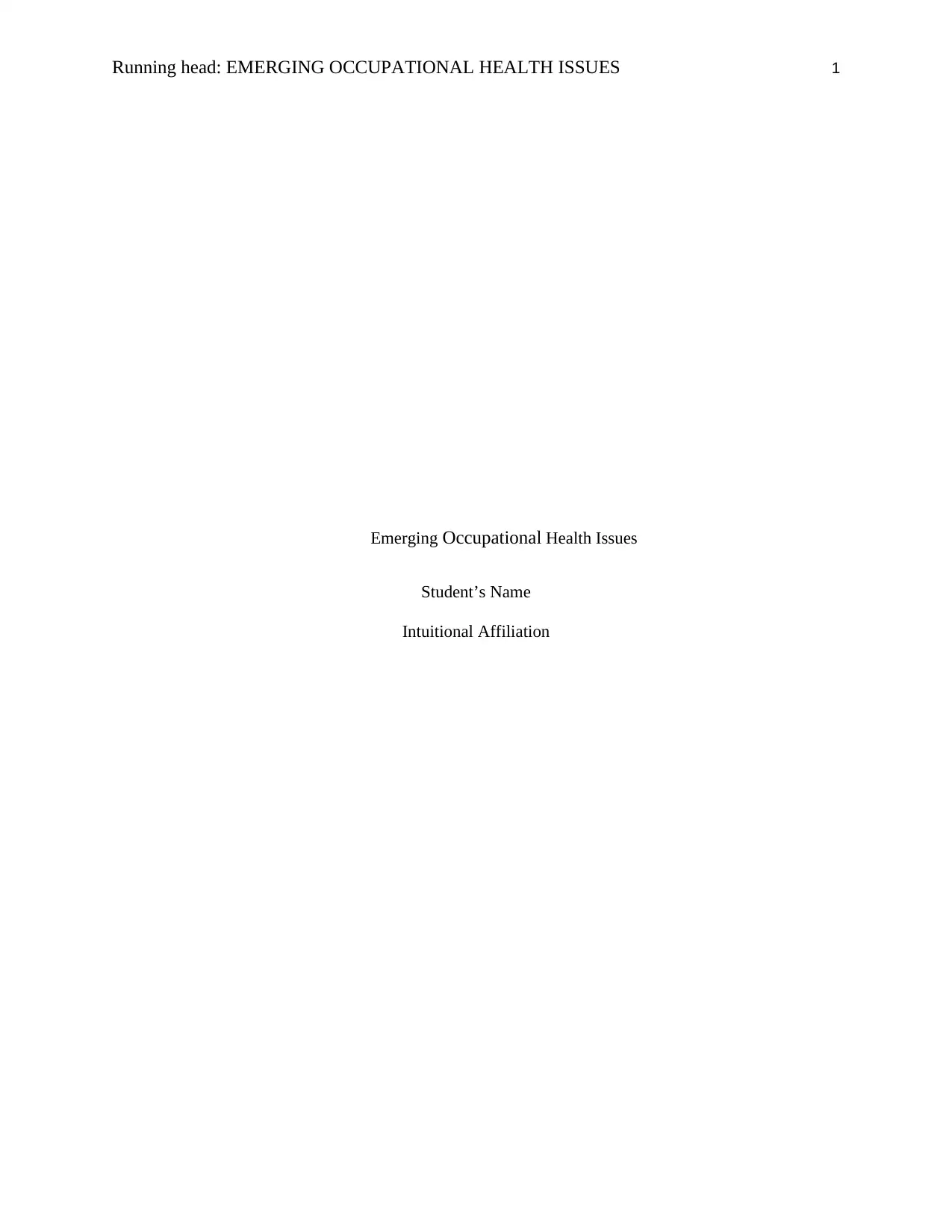
Running head: EMERGING OCCUPATIONAL HEALTH ISSUES 1
Emerging Occupational Health Issues
Student’s Name
Intuitional Affiliation
Emerging Occupational Health Issues
Student’s Name
Intuitional Affiliation
Paraphrase This Document
Need a fresh take? Get an instant paraphrase of this document with our AI Paraphraser
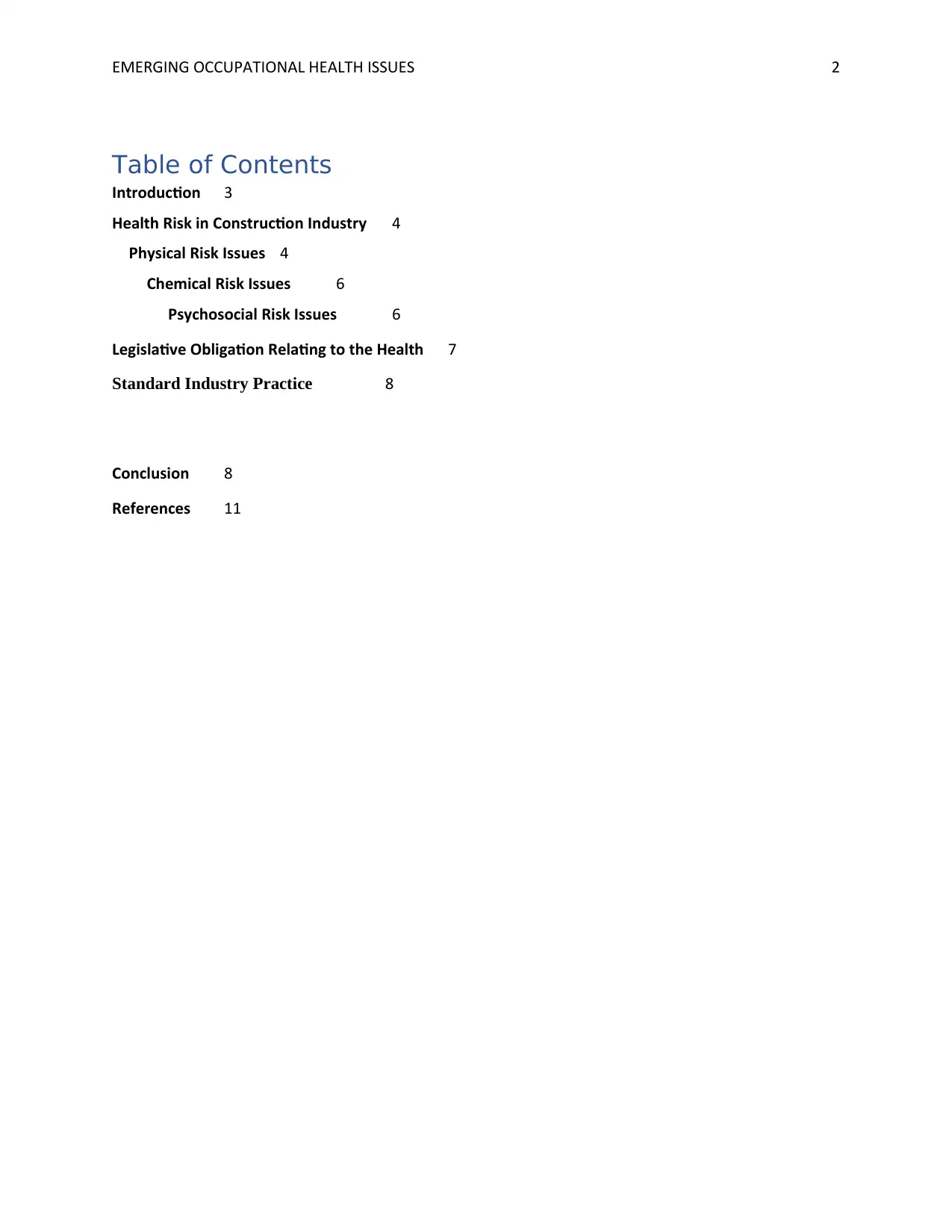
EMERGING OCCUPATIONAL HEALTH ISSUES 2
Table of Contents
Introduction 3
Health Risk in Construction Industry 4
Physical Risk Issues 4
Chemical Risk Issues 6
Psychosocial Risk Issues 6
Legislative Obligation Relating to the Health 7
Standard Industry Practice 8
Conclusion 8
References 11
Table of Contents
Introduction 3
Health Risk in Construction Industry 4
Physical Risk Issues 4
Chemical Risk Issues 6
Psychosocial Risk Issues 6
Legislative Obligation Relating to the Health 7
Standard Industry Practice 8
Conclusion 8
References 11
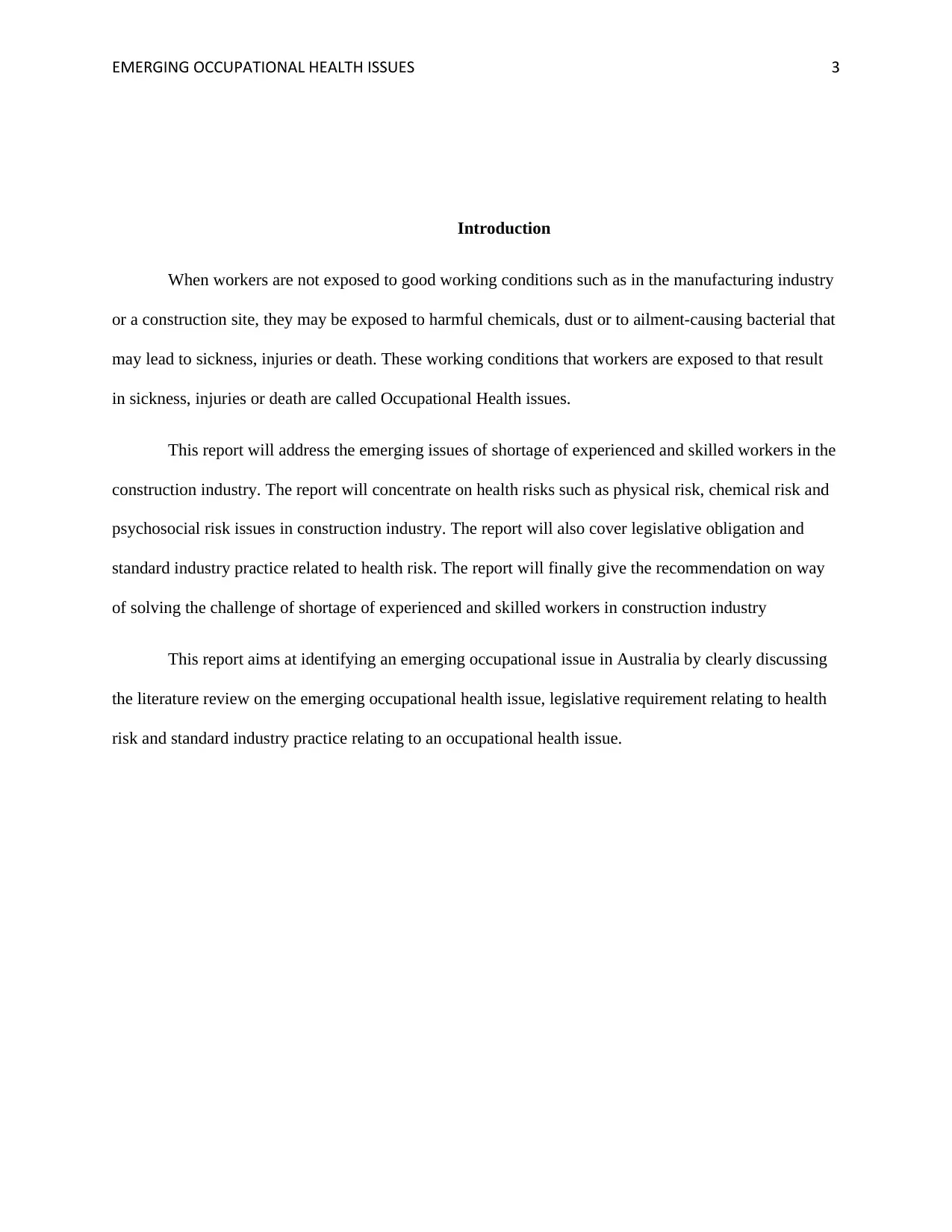
EMERGING OCCUPATIONAL HEALTH ISSUES 3
Introduction
When workers are not exposed to good working conditions such as in the manufacturing industry
or a construction site, they may be exposed to harmful chemicals, dust or to ailment-causing bacterial that
may lead to sickness, injuries or death. These working conditions that workers are exposed to that result
in sickness, injuries or death are called Occupational Health issues.
This report will address the emerging issues of shortage of experienced and skilled workers in the
construction industry. The report will concentrate on health risks such as physical risk, chemical risk and
psychosocial risk issues in construction industry. The report will also cover legislative obligation and
standard industry practice related to health risk. The report will finally give the recommendation on way
of solving the challenge of shortage of experienced and skilled workers in construction industry
This report aims at identifying an emerging occupational issue in Australia by clearly discussing
the literature review on the emerging occupational health issue, legislative requirement relating to health
risk and standard industry practice relating to an occupational health issue.
Introduction
When workers are not exposed to good working conditions such as in the manufacturing industry
or a construction site, they may be exposed to harmful chemicals, dust or to ailment-causing bacterial that
may lead to sickness, injuries or death. These working conditions that workers are exposed to that result
in sickness, injuries or death are called Occupational Health issues.
This report will address the emerging issues of shortage of experienced and skilled workers in the
construction industry. The report will concentrate on health risks such as physical risk, chemical risk and
psychosocial risk issues in construction industry. The report will also cover legislative obligation and
standard industry practice related to health risk. The report will finally give the recommendation on way
of solving the challenge of shortage of experienced and skilled workers in construction industry
This report aims at identifying an emerging occupational issue in Australia by clearly discussing
the literature review on the emerging occupational health issue, legislative requirement relating to health
risk and standard industry practice relating to an occupational health issue.
⊘ This is a preview!⊘
Do you want full access?
Subscribe today to unlock all pages.

Trusted by 1+ million students worldwide
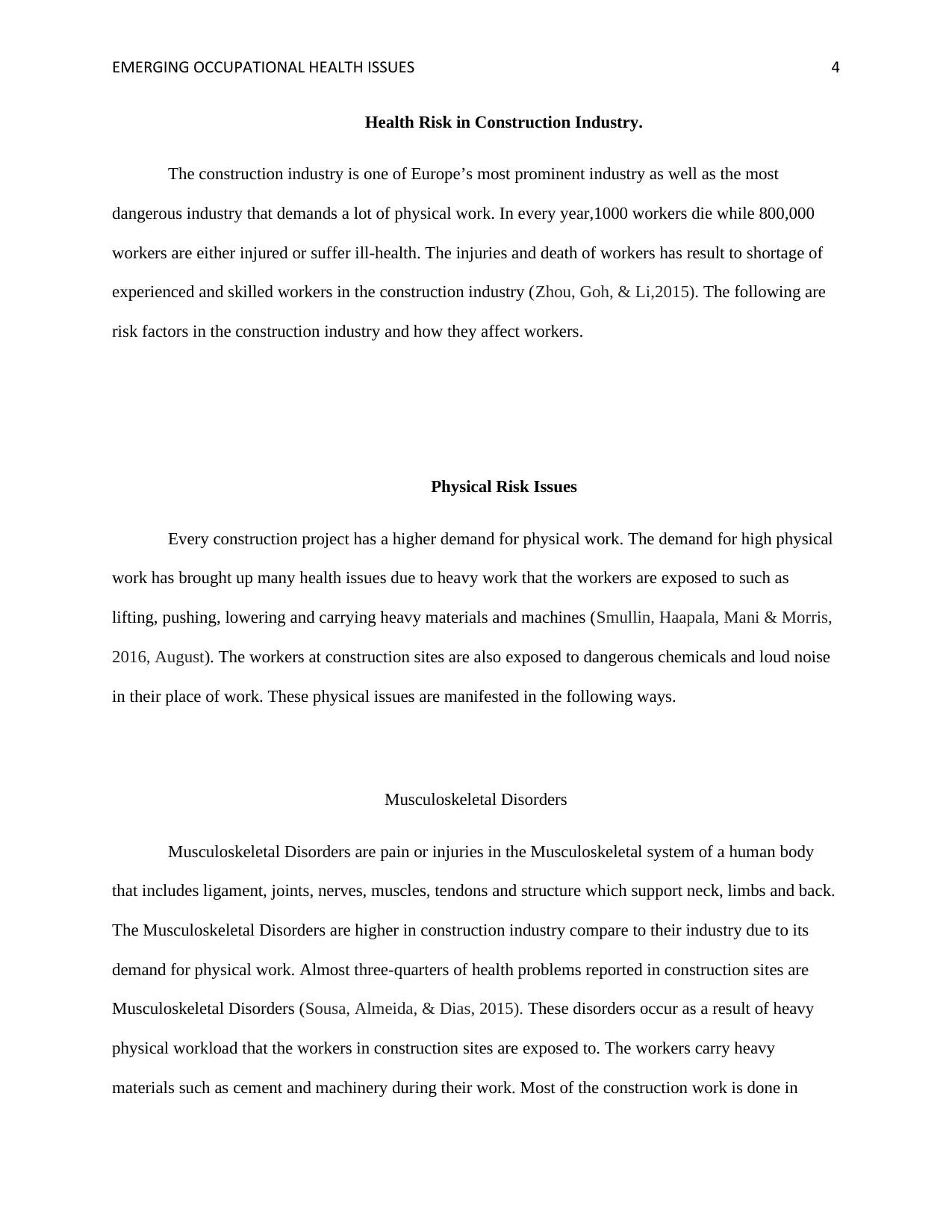
EMERGING OCCUPATIONAL HEALTH ISSUES 4
Health Risk in Construction Industry.
The construction industry is one of Europe’s most prominent industry as well as the most
dangerous industry that demands a lot of physical work. In every year,1000 workers die while 800,000
workers are either injured or suffer ill-health. The injuries and death of workers has result to shortage of
experienced and skilled workers in the construction industry (Zhou, Goh, & Li,2015). The following are
risk factors in the construction industry and how they affect workers.
Physical Risk Issues
Every construction project has a higher demand for physical work. The demand for high physical
work has brought up many health issues due to heavy work that the workers are exposed to such as
lifting, pushing, lowering and carrying heavy materials and machines (Smullin, Haapala, Mani & Morris,
2016, August). The workers at construction sites are also exposed to dangerous chemicals and loud noise
in their place of work. These physical issues are manifested in the following ways.
Musculoskeletal Disorders
Musculoskeletal Disorders are pain or injuries in the Musculoskeletal system of a human body
that includes ligament, joints, nerves, muscles, tendons and structure which support neck, limbs and back.
The Musculoskeletal Disorders are higher in construction industry compare to their industry due to its
demand for physical work. Almost three-quarters of health problems reported in construction sites are
Musculoskeletal Disorders (Sousa, Almeida, & Dias, 2015). These disorders occur as a result of heavy
physical workload that the workers in construction sites are exposed to. The workers carry heavy
materials such as cement and machinery during their work. Most of the construction work is done in
Health Risk in Construction Industry.
The construction industry is one of Europe’s most prominent industry as well as the most
dangerous industry that demands a lot of physical work. In every year,1000 workers die while 800,000
workers are either injured or suffer ill-health. The injuries and death of workers has result to shortage of
experienced and skilled workers in the construction industry (Zhou, Goh, & Li,2015). The following are
risk factors in the construction industry and how they affect workers.
Physical Risk Issues
Every construction project has a higher demand for physical work. The demand for high physical
work has brought up many health issues due to heavy work that the workers are exposed to such as
lifting, pushing, lowering and carrying heavy materials and machines (Smullin, Haapala, Mani & Morris,
2016, August). The workers at construction sites are also exposed to dangerous chemicals and loud noise
in their place of work. These physical issues are manifested in the following ways.
Musculoskeletal Disorders
Musculoskeletal Disorders are pain or injuries in the Musculoskeletal system of a human body
that includes ligament, joints, nerves, muscles, tendons and structure which support neck, limbs and back.
The Musculoskeletal Disorders are higher in construction industry compare to their industry due to its
demand for physical work. Almost three-quarters of health problems reported in construction sites are
Musculoskeletal Disorders (Sousa, Almeida, & Dias, 2015). These disorders occur as a result of heavy
physical workload that the workers in construction sites are exposed to. The workers carry heavy
materials such as cement and machinery during their work. Most of the construction work is done in
Paraphrase This Document
Need a fresh take? Get an instant paraphrase of this document with our AI Paraphraser
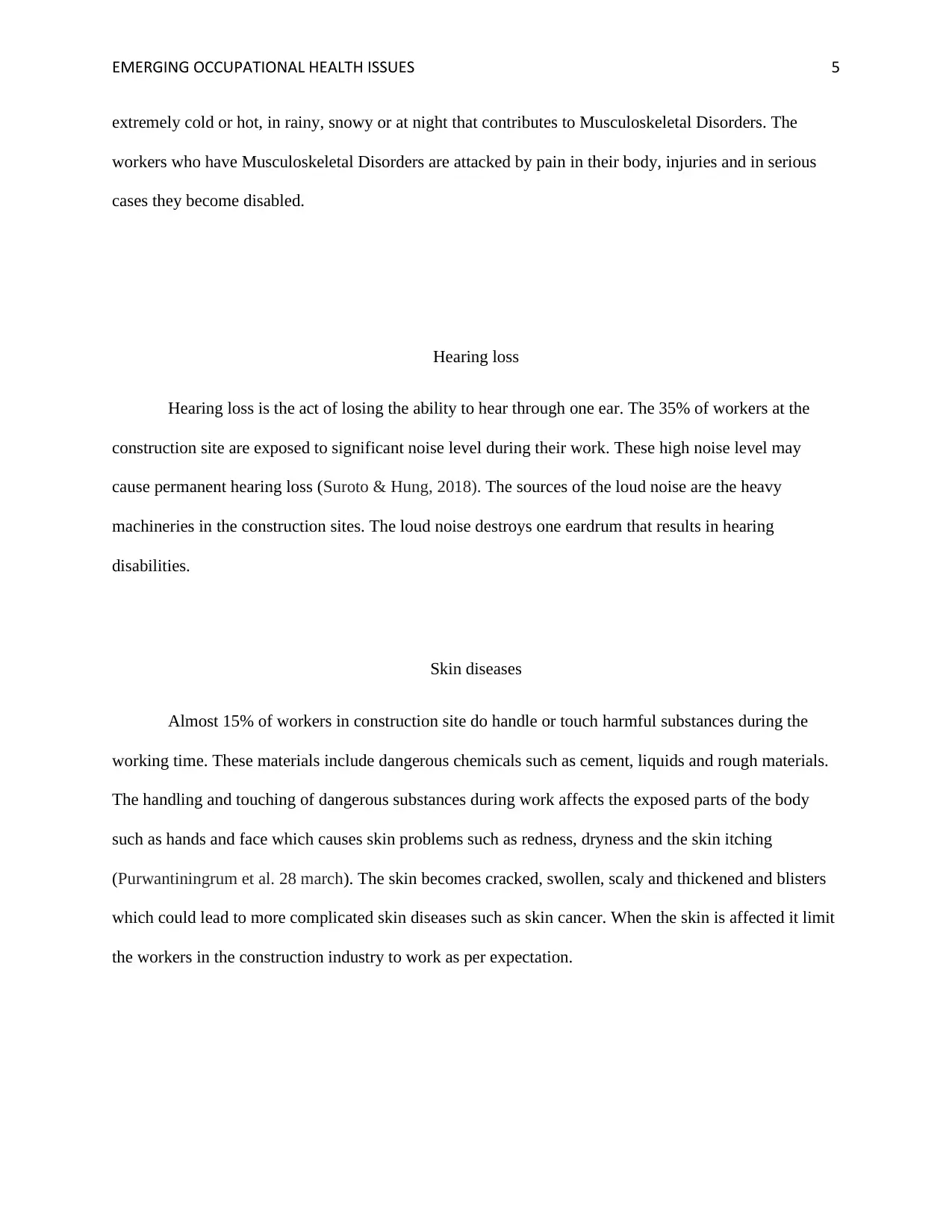
EMERGING OCCUPATIONAL HEALTH ISSUES 5
extremely cold or hot, in rainy, snowy or at night that contributes to Musculoskeletal Disorders. The
workers who have Musculoskeletal Disorders are attacked by pain in their body, injuries and in serious
cases they become disabled.
Hearing loss
Hearing loss is the act of losing the ability to hear through one ear. The 35% of workers at the
construction site are exposed to significant noise level during their work. These high noise level may
cause permanent hearing loss (Suroto & Hung, 2018). The sources of the loud noise are the heavy
machineries in the construction sites. The loud noise destroys one eardrum that results in hearing
disabilities.
Skin diseases
Almost 15% of workers in construction site do handle or touch harmful substances during the
working time. These materials include dangerous chemicals such as cement, liquids and rough materials.
The handling and touching of dangerous substances during work affects the exposed parts of the body
such as hands and face which causes skin problems such as redness, dryness and the skin itching
(Purwantiningrum et al. 28 march). The skin becomes cracked, swollen, scaly and thickened and blisters
which could lead to more complicated skin diseases such as skin cancer. When the skin is affected it limit
the workers in the construction industry to work as per expectation.
extremely cold or hot, in rainy, snowy or at night that contributes to Musculoskeletal Disorders. The
workers who have Musculoskeletal Disorders are attacked by pain in their body, injuries and in serious
cases they become disabled.
Hearing loss
Hearing loss is the act of losing the ability to hear through one ear. The 35% of workers at the
construction site are exposed to significant noise level during their work. These high noise level may
cause permanent hearing loss (Suroto & Hung, 2018). The sources of the loud noise are the heavy
machineries in the construction sites. The loud noise destroys one eardrum that results in hearing
disabilities.
Skin diseases
Almost 15% of workers in construction site do handle or touch harmful substances during the
working time. These materials include dangerous chemicals such as cement, liquids and rough materials.
The handling and touching of dangerous substances during work affects the exposed parts of the body
such as hands and face which causes skin problems such as redness, dryness and the skin itching
(Purwantiningrum et al. 28 march). The skin becomes cracked, swollen, scaly and thickened and blisters
which could lead to more complicated skin diseases such as skin cancer. When the skin is affected it limit
the workers in the construction industry to work as per expectation.
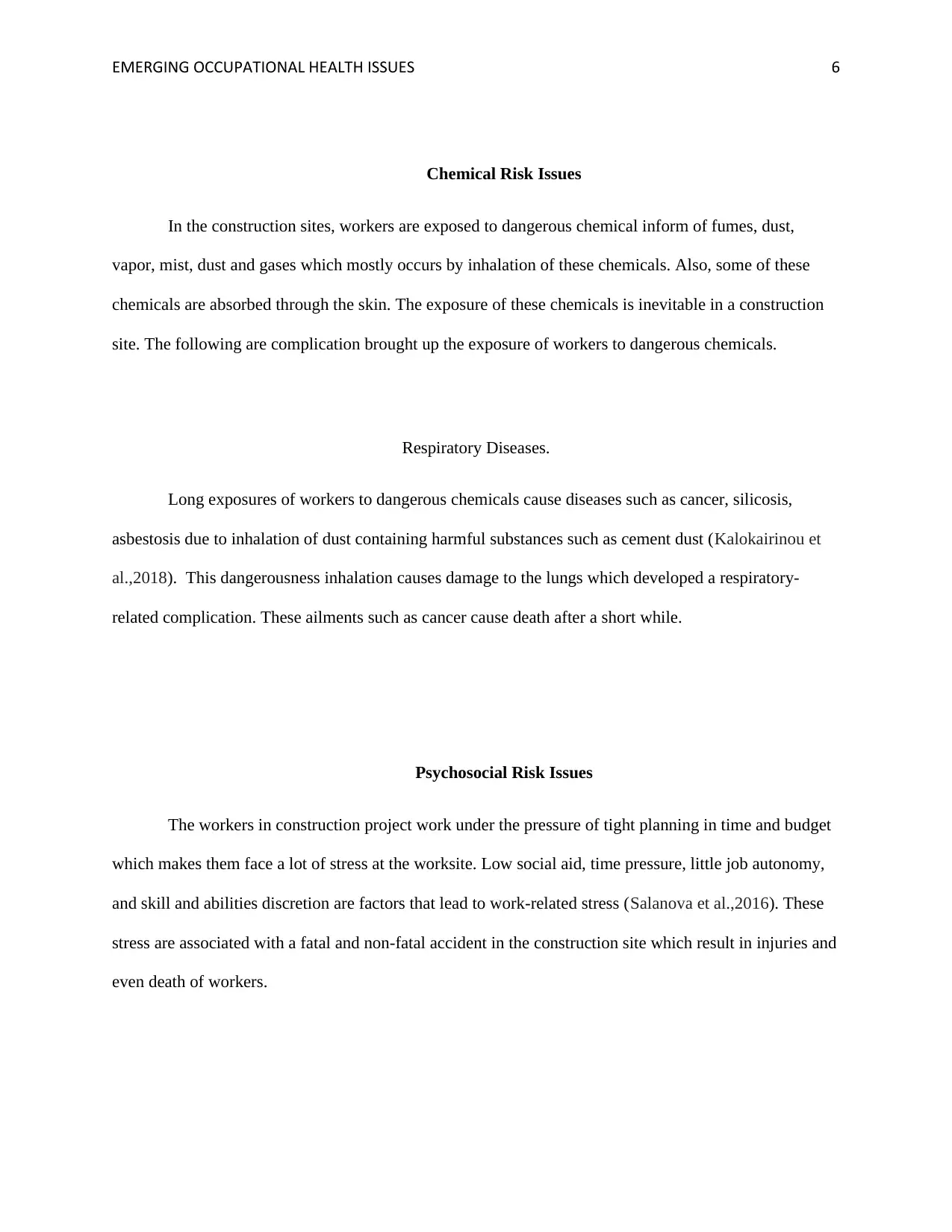
EMERGING OCCUPATIONAL HEALTH ISSUES 6
Chemical Risk Issues
In the construction sites, workers are exposed to dangerous chemical inform of fumes, dust,
vapor, mist, dust and gases which mostly occurs by inhalation of these chemicals. Also, some of these
chemicals are absorbed through the skin. The exposure of these chemicals is inevitable in a construction
site. The following are complication brought up the exposure of workers to dangerous chemicals.
Respiratory Diseases.
Long exposures of workers to dangerous chemicals cause diseases such as cancer, silicosis,
asbestosis due to inhalation of dust containing harmful substances such as cement dust (Kalokairinou et
al.,2018). This dangerousness inhalation causes damage to the lungs which developed a respiratory-
related complication. These ailments such as cancer cause death after a short while.
Psychosocial Risk Issues
The workers in construction project work under the pressure of tight planning in time and budget
which makes them face a lot of stress at the worksite. Low social aid, time pressure, little job autonomy,
and skill and abilities discretion are factors that lead to work-related stress (Salanova et al.,2016). These
stress are associated with a fatal and non-fatal accident in the construction site which result in injuries and
even death of workers.
Chemical Risk Issues
In the construction sites, workers are exposed to dangerous chemical inform of fumes, dust,
vapor, mist, dust and gases which mostly occurs by inhalation of these chemicals. Also, some of these
chemicals are absorbed through the skin. The exposure of these chemicals is inevitable in a construction
site. The following are complication brought up the exposure of workers to dangerous chemicals.
Respiratory Diseases.
Long exposures of workers to dangerous chemicals cause diseases such as cancer, silicosis,
asbestosis due to inhalation of dust containing harmful substances such as cement dust (Kalokairinou et
al.,2018). This dangerousness inhalation causes damage to the lungs which developed a respiratory-
related complication. These ailments such as cancer cause death after a short while.
Psychosocial Risk Issues
The workers in construction project work under the pressure of tight planning in time and budget
which makes them face a lot of stress at the worksite. Low social aid, time pressure, little job autonomy,
and skill and abilities discretion are factors that lead to work-related stress (Salanova et al.,2016). These
stress are associated with a fatal and non-fatal accident in the construction site which result in injuries and
even death of workers.
⊘ This is a preview!⊘
Do you want full access?
Subscribe today to unlock all pages.

Trusted by 1+ million students worldwide
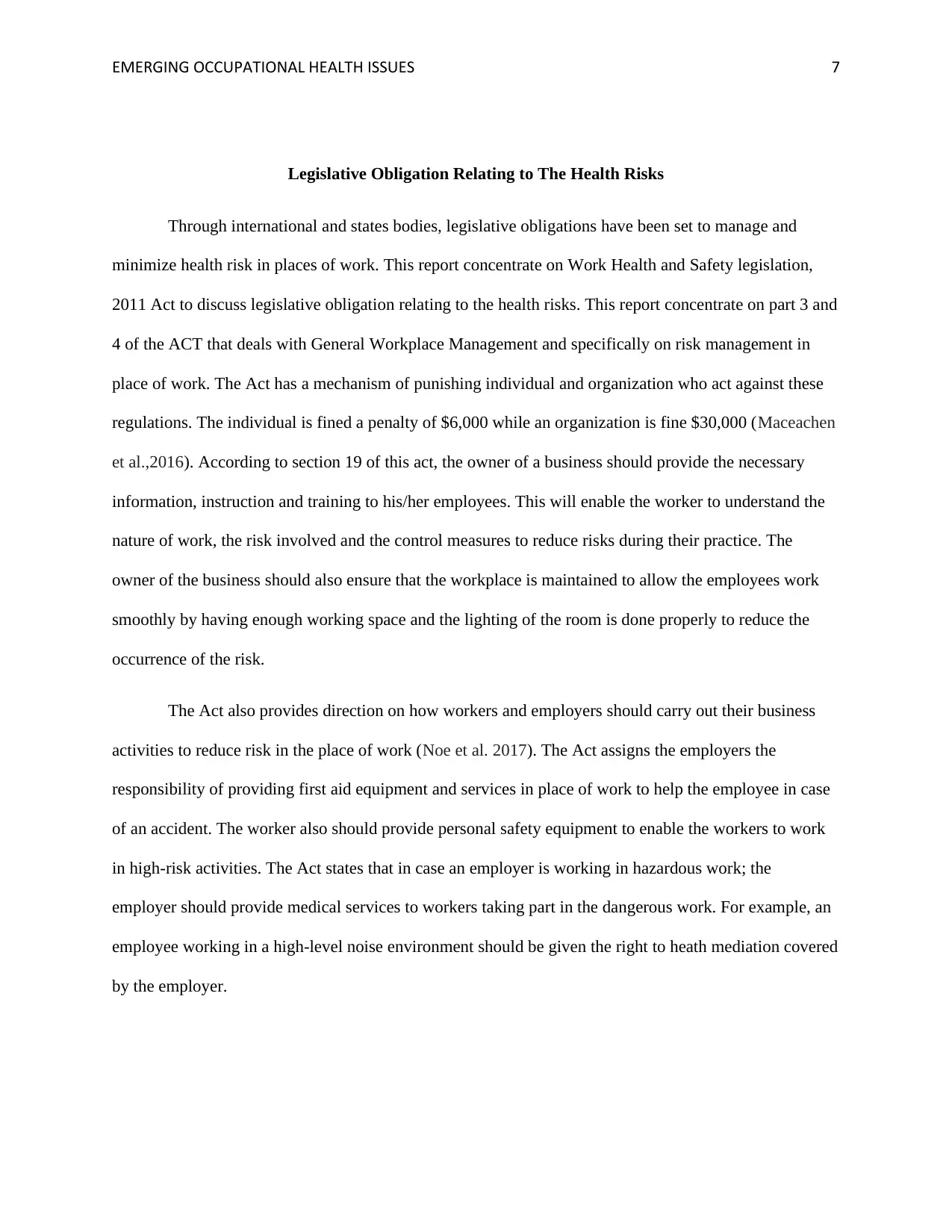
EMERGING OCCUPATIONAL HEALTH ISSUES 7
Legislative Obligation Relating to The Health Risks
Through international and states bodies, legislative obligations have been set to manage and
minimize health risk in places of work. This report concentrate on Work Health and Safety legislation,
2011 Act to discuss legislative obligation relating to the health risks. This report concentrate on part 3 and
4 of the ACT that deals with General Workplace Management and specifically on risk management in
place of work. The Act has a mechanism of punishing individual and organization who act against these
regulations. The individual is fined a penalty of $6,000 while an organization is fine $30,000 (Maceachen
et al.,2016). According to section 19 of this act, the owner of a business should provide the necessary
information, instruction and training to his/her employees. This will enable the worker to understand the
nature of work, the risk involved and the control measures to reduce risks during their practice. The
owner of the business should also ensure that the workplace is maintained to allow the employees work
smoothly by having enough working space and the lighting of the room is done properly to reduce the
occurrence of the risk.
The Act also provides direction on how workers and employers should carry out their business
activities to reduce risk in the place of work (Noe et al. 2017). The Act assigns the employers the
responsibility of providing first aid equipment and services in place of work to help the employee in case
of an accident. The worker also should provide personal safety equipment to enable the workers to work
in high-risk activities. The Act states that in case an employer is working in hazardous work; the
employer should provide medical services to workers taking part in the dangerous work. For example, an
employee working in a high-level noise environment should be given the right to heath mediation covered
by the employer.
Legislative Obligation Relating to The Health Risks
Through international and states bodies, legislative obligations have been set to manage and
minimize health risk in places of work. This report concentrate on Work Health and Safety legislation,
2011 Act to discuss legislative obligation relating to the health risks. This report concentrate on part 3 and
4 of the ACT that deals with General Workplace Management and specifically on risk management in
place of work. The Act has a mechanism of punishing individual and organization who act against these
regulations. The individual is fined a penalty of $6,000 while an organization is fine $30,000 (Maceachen
et al.,2016). According to section 19 of this act, the owner of a business should provide the necessary
information, instruction and training to his/her employees. This will enable the worker to understand the
nature of work, the risk involved and the control measures to reduce risks during their practice. The
owner of the business should also ensure that the workplace is maintained to allow the employees work
smoothly by having enough working space and the lighting of the room is done properly to reduce the
occurrence of the risk.
The Act also provides direction on how workers and employers should carry out their business
activities to reduce risk in the place of work (Noe et al. 2017). The Act assigns the employers the
responsibility of providing first aid equipment and services in place of work to help the employee in case
of an accident. The worker also should provide personal safety equipment to enable the workers to work
in high-risk activities. The Act states that in case an employer is working in hazardous work; the
employer should provide medical services to workers taking part in the dangerous work. For example, an
employee working in a high-level noise environment should be given the right to heath mediation covered
by the employer.
Paraphrase This Document
Need a fresh take? Get an instant paraphrase of this document with our AI Paraphraser
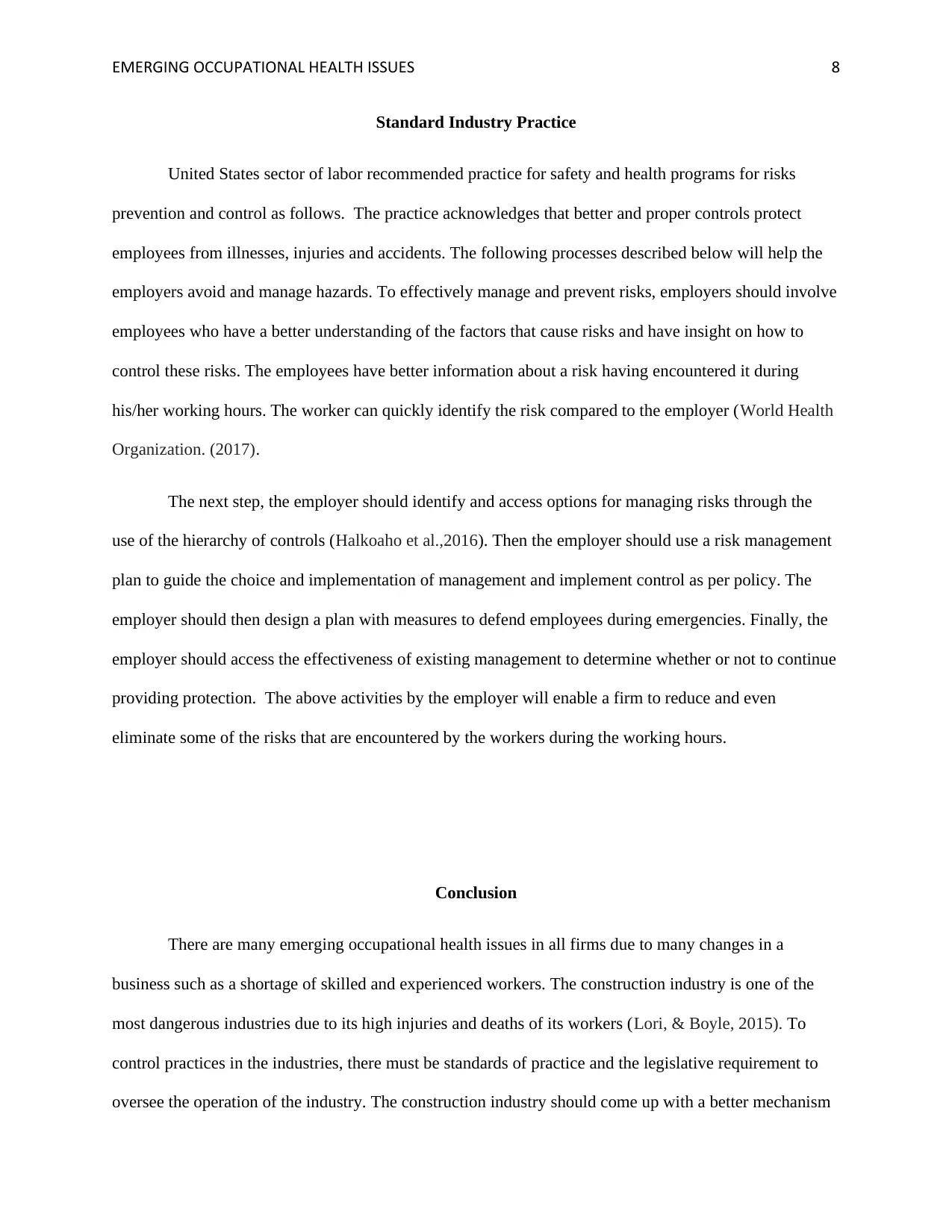
EMERGING OCCUPATIONAL HEALTH ISSUES 8
Standard Industry Practice
United States sector of labor recommended practice for safety and health programs for risks
prevention and control as follows. The practice acknowledges that better and proper controls protect
employees from illnesses, injuries and accidents. The following processes described below will help the
employers avoid and manage hazards. To effectively manage and prevent risks, employers should involve
employees who have a better understanding of the factors that cause risks and have insight on how to
control these risks. The employees have better information about a risk having encountered it during
his/her working hours. The worker can quickly identify the risk compared to the employer (World Health
Organization. (2017).
The next step, the employer should identify and access options for managing risks through the
use of the hierarchy of controls (Halkoaho et al.,2016). Then the employer should use a risk management
plan to guide the choice and implementation of management and implement control as per policy. The
employer should then design a plan with measures to defend employees during emergencies. Finally, the
employer should access the effectiveness of existing management to determine whether or not to continue
providing protection. The above activities by the employer will enable a firm to reduce and even
eliminate some of the risks that are encountered by the workers during the working hours.
Conclusion
There are many emerging occupational health issues in all firms due to many changes in a
business such as a shortage of skilled and experienced workers. The construction industry is one of the
most dangerous industries due to its high injuries and deaths of its workers (Lori, & Boyle, 2015). To
control practices in the industries, there must be standards of practice and the legislative requirement to
oversee the operation of the industry. The construction industry should come up with a better mechanism
Standard Industry Practice
United States sector of labor recommended practice for safety and health programs for risks
prevention and control as follows. The practice acknowledges that better and proper controls protect
employees from illnesses, injuries and accidents. The following processes described below will help the
employers avoid and manage hazards. To effectively manage and prevent risks, employers should involve
employees who have a better understanding of the factors that cause risks and have insight on how to
control these risks. The employees have better information about a risk having encountered it during
his/her working hours. The worker can quickly identify the risk compared to the employer (World Health
Organization. (2017).
The next step, the employer should identify and access options for managing risks through the
use of the hierarchy of controls (Halkoaho et al.,2016). Then the employer should use a risk management
plan to guide the choice and implementation of management and implement control as per policy. The
employer should then design a plan with measures to defend employees during emergencies. Finally, the
employer should access the effectiveness of existing management to determine whether or not to continue
providing protection. The above activities by the employer will enable a firm to reduce and even
eliminate some of the risks that are encountered by the workers during the working hours.
Conclusion
There are many emerging occupational health issues in all firms due to many changes in a
business such as a shortage of skilled and experienced workers. The construction industry is one of the
most dangerous industries due to its high injuries and deaths of its workers (Lori, & Boyle, 2015). To
control practices in the industries, there must be standards of practice and the legislative requirement to
oversee the operation of the industry. The construction industry should come up with a better mechanism
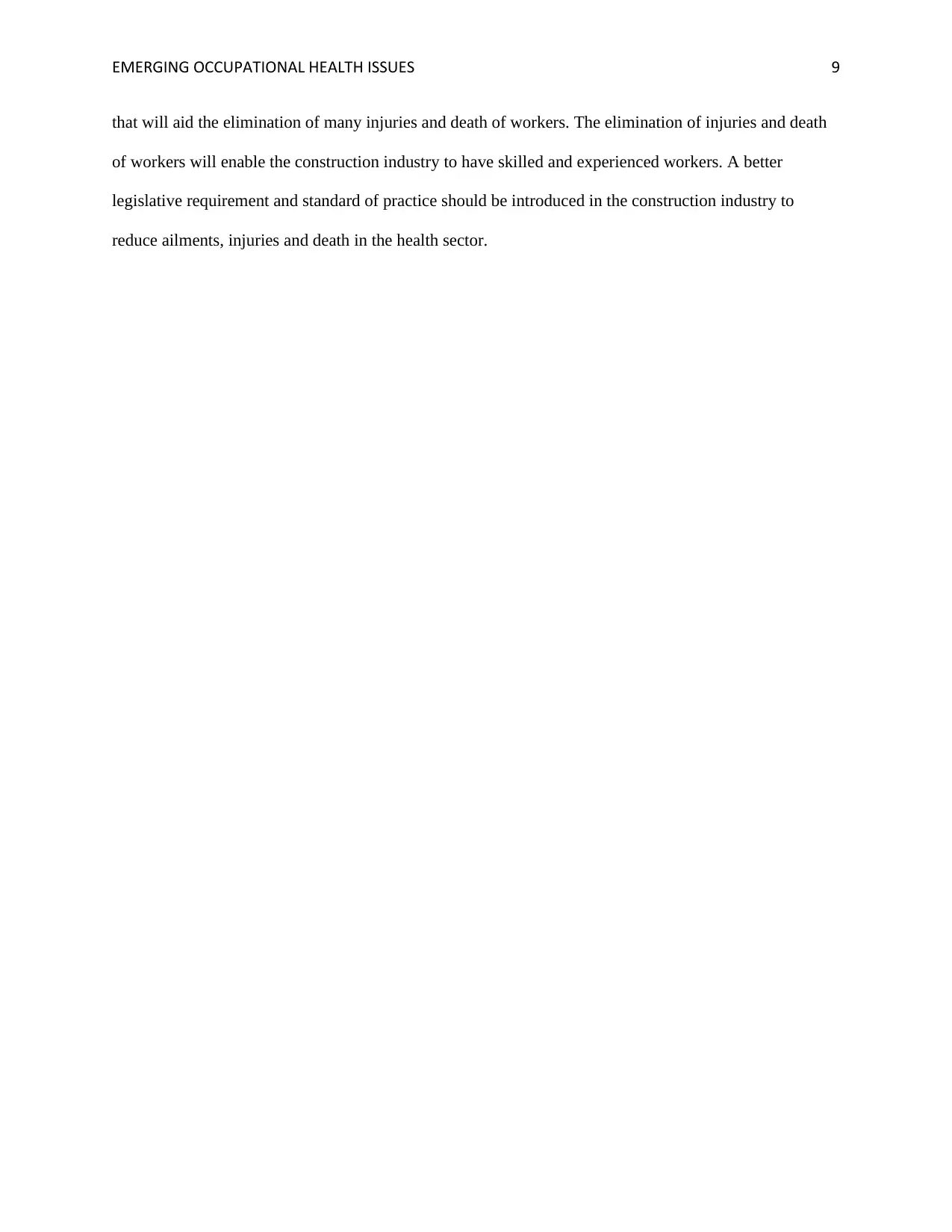
EMERGING OCCUPATIONAL HEALTH ISSUES 9
that will aid the elimination of many injuries and death of workers. The elimination of injuries and death
of workers will enable the construction industry to have skilled and experienced workers. A better
legislative requirement and standard of practice should be introduced in the construction industry to
reduce ailments, injuries and death in the health sector.
that will aid the elimination of many injuries and death of workers. The elimination of injuries and death
of workers will enable the construction industry to have skilled and experienced workers. A better
legislative requirement and standard of practice should be introduced in the construction industry to
reduce ailments, injuries and death in the health sector.
⊘ This is a preview!⊘
Do you want full access?
Subscribe today to unlock all pages.

Trusted by 1+ million students worldwide
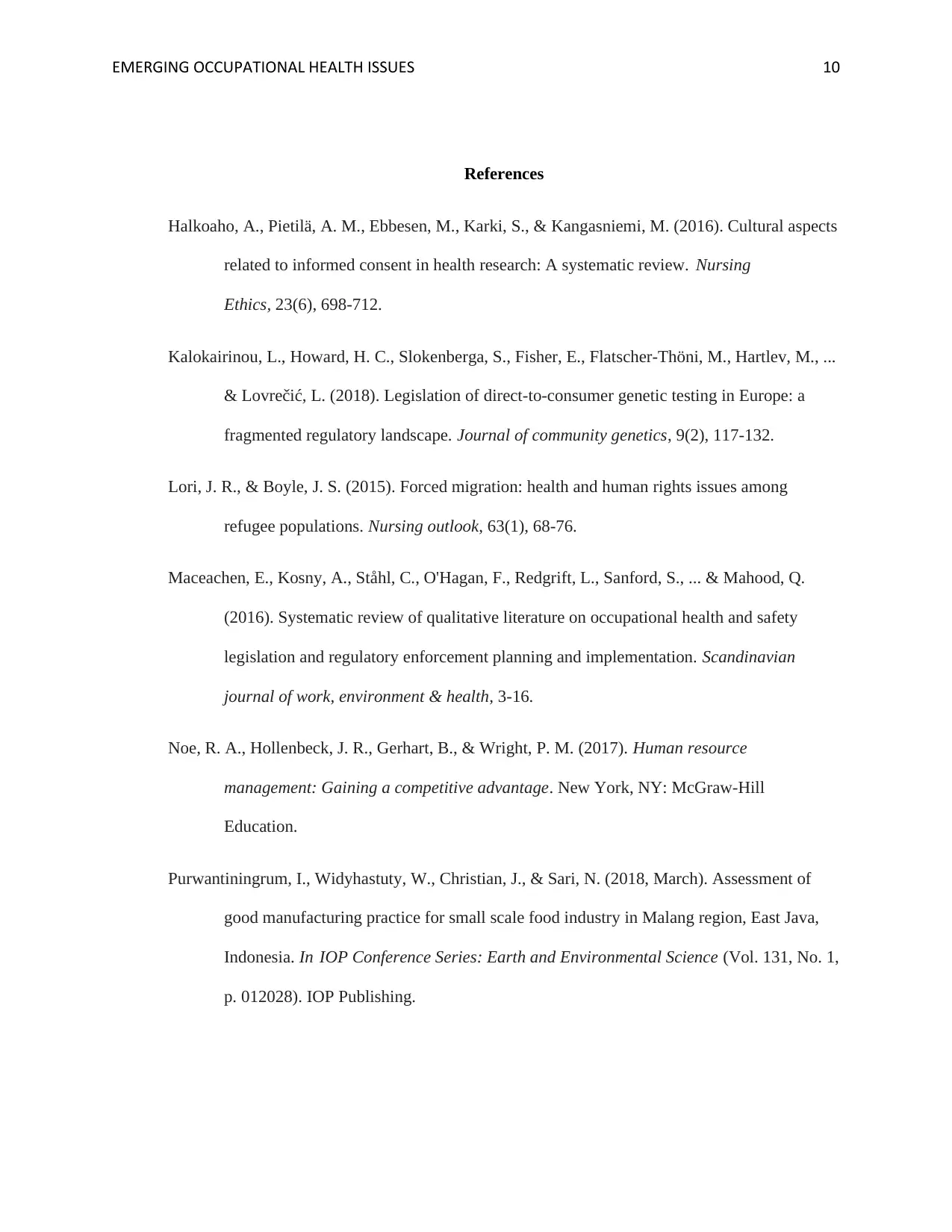
EMERGING OCCUPATIONAL HEALTH ISSUES 10
References
Halkoaho, A., Pietilä, A. M., Ebbesen, M., Karki, S., & Kangasniemi, M. (2016). Cultural aspects
related to informed consent in health research: A systematic review. Nursing
Ethics, 23(6), 698-712.
Kalokairinou, L., Howard, H. C., Slokenberga, S., Fisher, E., Flatscher-Thöni, M., Hartlev, M., ...
& Lovrečić, L. (2018). Legislation of direct-to-consumer genetic testing in Europe: a
fragmented regulatory landscape. Journal of community genetics, 9(2), 117-132.
Lori, J. R., & Boyle, J. S. (2015). Forced migration: health and human rights issues among
refugee populations. Nursing outlook, 63(1), 68-76.
Maceachen, E., Kosny, A., Ståhl, C., O'Hagan, F., Redgrift, L., Sanford, S., ... & Mahood, Q.
(2016). Systematic review of qualitative literature on occupational health and safety
legislation and regulatory enforcement planning and implementation. Scandinavian
journal of work, environment & health, 3-16.
Noe, R. A., Hollenbeck, J. R., Gerhart, B., & Wright, P. M. (2017). Human resource
management: Gaining a competitive advantage. New York, NY: McGraw-Hill
Education.
Purwantiningrum, I., Widyhastuty, W., Christian, J., & Sari, N. (2018, March). Assessment of
good manufacturing practice for small scale food industry in Malang region, East Java,
Indonesia. In IOP Conference Series: Earth and Environmental Science (Vol. 131, No. 1,
p. 012028). IOP Publishing.
References
Halkoaho, A., Pietilä, A. M., Ebbesen, M., Karki, S., & Kangasniemi, M. (2016). Cultural aspects
related to informed consent in health research: A systematic review. Nursing
Ethics, 23(6), 698-712.
Kalokairinou, L., Howard, H. C., Slokenberga, S., Fisher, E., Flatscher-Thöni, M., Hartlev, M., ...
& Lovrečić, L. (2018). Legislation of direct-to-consumer genetic testing in Europe: a
fragmented regulatory landscape. Journal of community genetics, 9(2), 117-132.
Lori, J. R., & Boyle, J. S. (2015). Forced migration: health and human rights issues among
refugee populations. Nursing outlook, 63(1), 68-76.
Maceachen, E., Kosny, A., Ståhl, C., O'Hagan, F., Redgrift, L., Sanford, S., ... & Mahood, Q.
(2016). Systematic review of qualitative literature on occupational health and safety
legislation and regulatory enforcement planning and implementation. Scandinavian
journal of work, environment & health, 3-16.
Noe, R. A., Hollenbeck, J. R., Gerhart, B., & Wright, P. M. (2017). Human resource
management: Gaining a competitive advantage. New York, NY: McGraw-Hill
Education.
Purwantiningrum, I., Widyhastuty, W., Christian, J., & Sari, N. (2018, March). Assessment of
good manufacturing practice for small scale food industry in Malang region, East Java,
Indonesia. In IOP Conference Series: Earth and Environmental Science (Vol. 131, No. 1,
p. 012028). IOP Publishing.
Paraphrase This Document
Need a fresh take? Get an instant paraphrase of this document with our AI Paraphraser
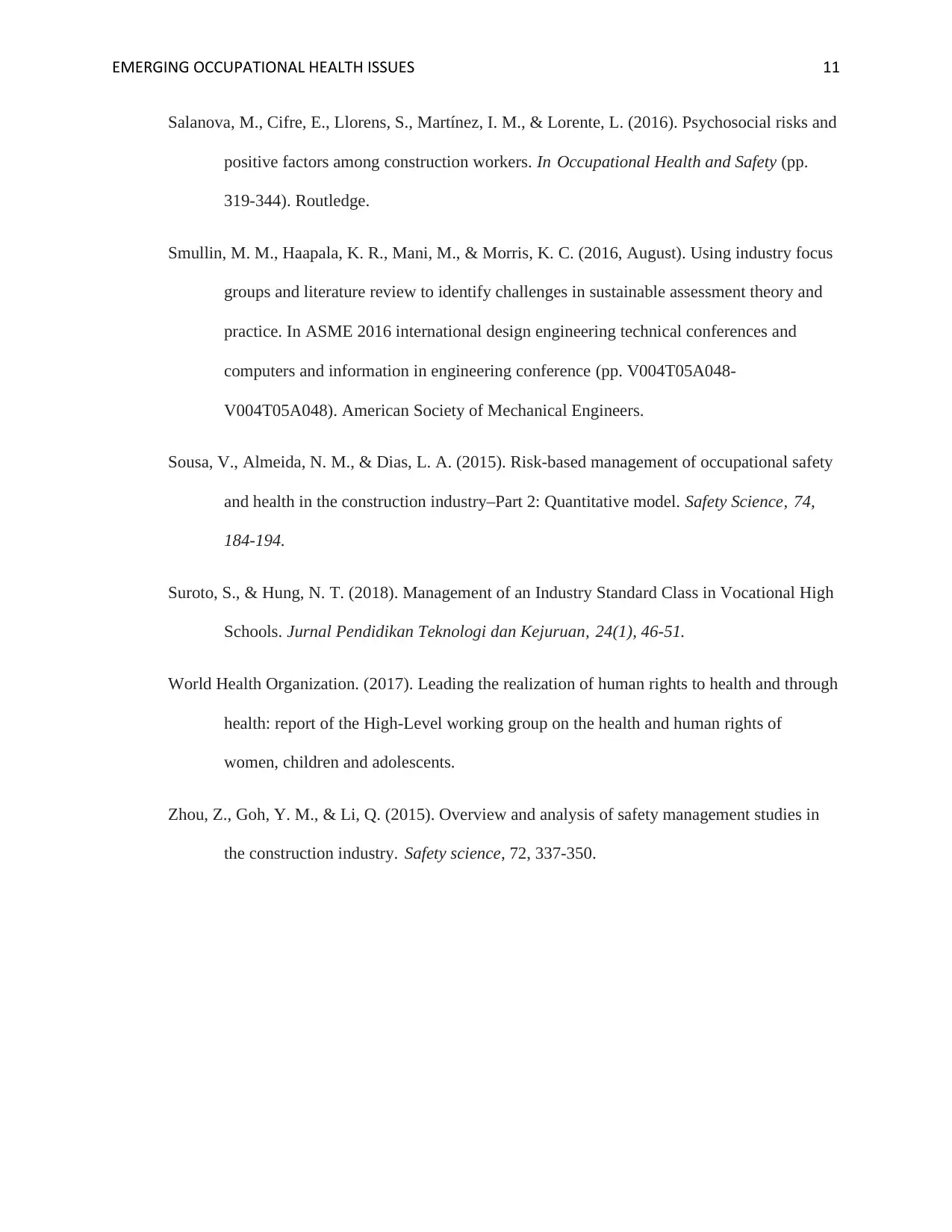
EMERGING OCCUPATIONAL HEALTH ISSUES 11
Salanova, M., Cifre, E., Llorens, S., Martínez, I. M., & Lorente, L. (2016). Psychosocial risks and
positive factors among construction workers. In Occupational Health and Safety (pp.
319-344). Routledge.
Smullin, M. M., Haapala, K. R., Mani, M., & Morris, K. C. (2016, August). Using industry focus
groups and literature review to identify challenges in sustainable assessment theory and
practice. In ASME 2016 international design engineering technical conferences and
computers and information in engineering conference (pp. V004T05A048-
V004T05A048). American Society of Mechanical Engineers.
Sousa, V., Almeida, N. M., & Dias, L. A. (2015). Risk-based management of occupational safety
and health in the construction industry–Part 2: Quantitative model. Safety Science, 74,
184-194.
Suroto, S., & Hung, N. T. (2018). Management of an Industry Standard Class in Vocational High
Schools. Jurnal Pendidikan Teknologi dan Kejuruan, 24(1), 46-51.
World Health Organization. (2017). Leading the realization of human rights to health and through
health: report of the High-Level working group on the health and human rights of
women, children and adolescents.
Zhou, Z., Goh, Y. M., & Li, Q. (2015). Overview and analysis of safety management studies in
the construction industry. Safety science, 72, 337-350.
Salanova, M., Cifre, E., Llorens, S., Martínez, I. M., & Lorente, L. (2016). Psychosocial risks and
positive factors among construction workers. In Occupational Health and Safety (pp.
319-344). Routledge.
Smullin, M. M., Haapala, K. R., Mani, M., & Morris, K. C. (2016, August). Using industry focus
groups and literature review to identify challenges in sustainable assessment theory and
practice. In ASME 2016 international design engineering technical conferences and
computers and information in engineering conference (pp. V004T05A048-
V004T05A048). American Society of Mechanical Engineers.
Sousa, V., Almeida, N. M., & Dias, L. A. (2015). Risk-based management of occupational safety
and health in the construction industry–Part 2: Quantitative model. Safety Science, 74,
184-194.
Suroto, S., & Hung, N. T. (2018). Management of an Industry Standard Class in Vocational High
Schools. Jurnal Pendidikan Teknologi dan Kejuruan, 24(1), 46-51.
World Health Organization. (2017). Leading the realization of human rights to health and through
health: report of the High-Level working group on the health and human rights of
women, children and adolescents.
Zhou, Z., Goh, Y. M., & Li, Q. (2015). Overview and analysis of safety management studies in
the construction industry. Safety science, 72, 337-350.
1 out of 11
Related Documents
Your All-in-One AI-Powered Toolkit for Academic Success.
+13062052269
info@desklib.com
Available 24*7 on WhatsApp / Email
![[object Object]](/_next/static/media/star-bottom.7253800d.svg)
Unlock your academic potential
Copyright © 2020–2025 A2Z Services. All Rights Reserved. Developed and managed by ZUCOL.





